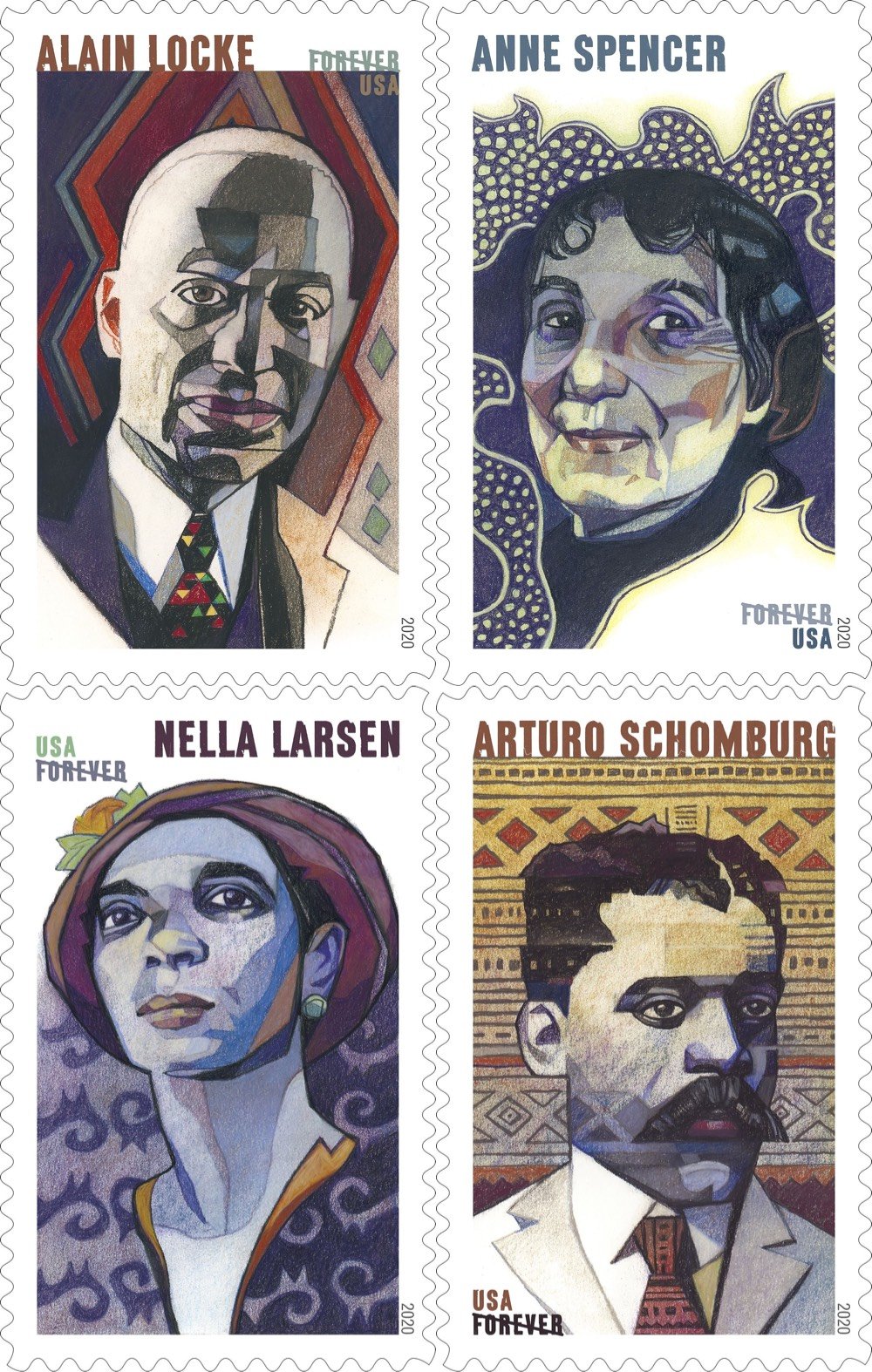New USPS Stamps Feature Prominent Voices of the Harlem Renaissance

The USPS recently released a set of four stamps honoring prominent literary figures of the Harlem Renaissance. They are available for purchase on the USPS site.
The Harlem Renaissance of the 1920s was one of the great artistic and literary movements in American history. As African-American writers and artists pushed the boundaries of their identities and their art, they created a diverse body of work that explored their shared history and experience, embodied the spirit of the times, and let new and distinctive voices be heard.
The stamps feature Nella Larsen, Alain Locke, Arturo Alfonso Schomburg, and Anne Spencer. Larsen was the author of two novels: Quicksand and Passing. From Larsen’s “overlooked” obituary in the NY Times:
Larsen followed “Quicksand” the next year with “Passing,” which tells the story of Irene Redfield and Clare Kendry, two mixed-race women who grew up together and reunite at a Chicago hotel after years of separation. Clare, Irene discovers, has been living as a white woman married to a racist who is none the wiser about his wife’s background. The relationship between the two women flirts with the sensual as each becomes obsessed with the other’s chosen path.
Upon reading that, I immediately thought “that would make an amazing movie” — and indeed, Tessa Thompson and Ruth Negga are starring in an upcoming adaptation. You can read more about Larsen in Thadious M. Davis’ biography.
Alain Locke was the first African-American Rhodes Scholar and is acknowledged as the “dean” of the Harlem Renaissance due to the publication of The New Negro, an anthology of writing from authors like Langston Hughes and Zora Neale Hurston that would come to define the Harlem Renaissance. The seminal text on Locke is Jeffrey Stewart’s 2018 National Book Award-winning biography, The New Negro: The Life of Alain Locke.
In The New Negro: The Life of Alain Locke, Jeffrey C. Stewart offers the definitive biography of the father of the Harlem Renaissance, based on the extant primary sources of his life and on interviews with those who knew him personally. He narrates the education of Locke, including his becoming the first African American Rhodes Scholar and earning a PhD in philosophy at Harvard University, and his long career as a professor at Howard University. Locke also received a cosmopolitan, aesthetic education through his travels in continental Europe, where he came to appreciate the beauty of art and experienced a freedom unknown to him in the United States. And yet he became most closely associated with the flowering of Black culture in Jazz Age America and his promotion of the literary and artistic work of African Americans as the quintessential creations of American modernism.
Also of note: Locke’s father was the first Black civil-service employee of the USPS.
Originally from Puerto Rico, Arturo Alfonso Schomburg was a historian, writer, activist, and curator of Black art and literature. He co-founded the Negro Society for Historical Research and his collection eventually became part of the NYPL system as the Schomburg Center for Research in Black Culture. Schomburg’s 1925 essay The Negro Digs Up His Past was included in Alain Locke’s The New Negro.
Anne Spencer was a poet, activist, and librarian. The Anne Spencer House and Garden Museum has an extensive biography of Spencer.
In addition to her writing, Spencer helped to found the Lynchburg Chapter of the National Association for the Advancement of Colored People (NAACP). She was also the librarian at the all-black Dunbar High School, a position she held for 20 years. Here she supplemented the original three books by bringing others from her own collection at home, as well as those provided by her employer, the all-white Jones Memorial Library. She spent much of her time writing and serving on local committees to improve the legal, social, and economic aspects of African Americans’ lives.
I found several of her poems online (here and here) but a pair of anthologies are long out of print. One of her most influential poems, White Things, was published in 1923. It begins:
Most things are colorful things—the sky, earth, and sea.
Black men are most men; but the white are free! White things are rare things; so rare, so rare
They stole from out a silvered world—somewhere.
Notable Black American Women called the poem “the quintessential ‘protest’ poem”. (via colossal)





Stay Connected